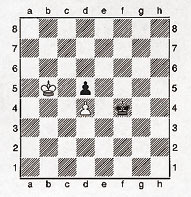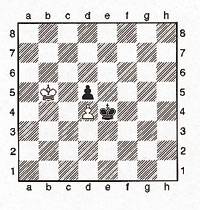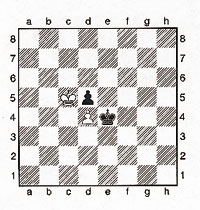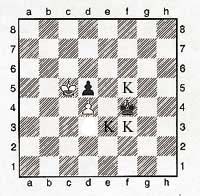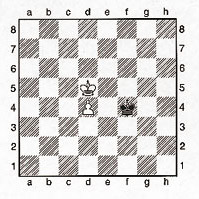click to enlarge

Figure1 Ludwig Wittgenstein
(1889-1951)
click to enlarge
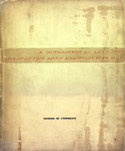
Figure. 2
Marcel Duchmap,Opposition
and Sister Squares are
Reconciled,1932
According to my Wittgenstein CD(1), there are 181 tokens of the word “chess” and its cognates (such as “chessboard”) in the Blackwell published works of Wittgenstein. We begin, however, with the French/American artist and chess master Marcel Duchamp (1887-1968). Duchamp, co-wrote a magisterial chess book titled: Opposition and Sister Squares are Reconciled.(2) (Fig. 2)The special subject of this specialist’s book is King and Pawn endings.
One of the simpler positions Duchamp analyzes is: (Diagram 1)
Black’s temptation is to swoop in (with 1 … Ke4, as in (Diagram. 2)) and attack the White Pawn. But, as Duchamp explains:
It would be wrong to begin with 1 … Ke4, [as in (Diagram. 2)] because of 2 Kc5 (Diagram. 3) and White would win the P[awn]. This manoeuvre is known as “trébuchet”. (3)
click images to enlarge
Black’s only move now is to retreat to one of the squares marked with a “K” in (Diagram. 4), allowing White to snatch the pawn(Diagram. 5)and go on to win. Black’s first, obvious, aggressive, materialistic (but unreflective) move, going straight to the undefended pawn, turns out to be a kind of suicide. (Taking one’s time would have done the trick.)
click images to enlarge
Tolstoy wrote that “Happy families are all alike; every unhappy family is unhappy in its own way.” Is this the same for mistakes? Is each one a mistake in its own way? 1 … Ke4 is not, I would think, the same kind of mistake that Oedipus made when he married Jocasta (although both involve regicide). What kind of mistake is 1 … Ke4? Why would anyone make this move? What might tempt or compel someone here? Chess, after all, is not baseball; it is not as if the lights were too low, or Black lost the pawn in the sun.
In a book titled How Not to Play Chess, Duchamp’s friend Grandmaster Eugene A. Znosko-Borovsky wrote:
The great privilege of our game is that there is nothing hidden; everyone can see all that is on the chessboard, and, what is more, no piece can remain unnoticed. It is necessary only to be able to see […](4)
Another grandmaster friend of Duchamp, Larry Evans, continues our theme in a book titledThe 10 Most Common Chess Mistakes … and how to avoid them!:
After all, everything is open and above-board. The element of deception is at a minimum, and there are no closed hands, as in bridge.(5)
This might seem familiar to some of you, even to those of you who don’t read esoteric chess literature. It might remind you of remark 129 of Wittgenstein’s Philosophical Investigations:
The aspects of things that are most important for us are hidden because of their simplicity and familiarity. (One is unable to notice something–because it is always before one’s eyes.) The real foundations of his enquiry do not strike a man at all. Unless that fact has at some time struck him.–And this means: we fail to be struck by what, once seen, is most striking and most powerful.
Or of this early claim in The Blue Book:
This kind of mistake recurs again and again in philosophy; e.g. when we are puzzled about the nature of time, when time seems to us a queer thing. We are most strongly tempted to think that here are things hidden, something we can see from the outside but which we can’t look into. And yet nothing of the sort is the case. It is not new facts about time which we want to know. All the facts that concern us lie open before us. [BB: p. 6](6)
Or from remark 89 of the Investigations:
We want to understand something that is already in plain view.
click to enlarge

Figure 3
Marcel Duchamp, Trébuchet, 1917/1964
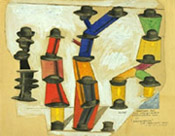
Figure 4
Max Ernst, The Hat Makes the Man, 1920
Let us go from one kind of Duchampian trébuchet to another. Consider these two images:
Marcel Duchamp’s Trébuchet (Fig. 3) Max Ernst’s The Hat Makes the Man(7)(Fig. 4)
The first, Duchamp’s Trébuchet, is a photograph of a 1964 reproduction of a lost 1917 readymade. The second is Max Ernst’s mixed media work from 1920: cut-and-pasted paper, pencil, ink and watercolor on paper. The first has all the initial appearances of an ordinary, store-bought coat and hat rack, whereas the second looks alien and bizarre (in the 1930s English of the Blue and Brown Books: queer; in Freud’s German: unheimlich, uncanny.). This contrast between thefamiliar and the unfamiliar interested Wittgenstein throughout his career, and plays a central role in examining our subtitled theme of Wittgenstein on mistakes of surface and depth.
I want to ask you to indulge me and perform a Wittgensteinean experiment (which I will take advantage of later). While studying these two images, ask yourself: what do you experience when you look at them; in particular, do you have a feeling of familiarity?
In order to force the experiment, before studying these images read the following from Wittgenstein’s Brown Book:
24. Let us now go back to the idea of a feeling of familiarity, which arises when I see familiar objects. Pondering about the question whether there is such a feeling or not, we are likely to gaze at some object and say, “Don’t I have a particular feeling when I look at my old coat and hat?” (p. 180)
In this thematic neighborhood Wittgenstein’s philosophical language often employs metaphors that are aesthetic or come from the arts: looking at pictures, going to the movies, listening to music. My use of the two artists’ coat and hat racks is partly designed to make more transparent what Wittgenstein achieves philosophically with his use of these metaphors. In one of the most explicit statements of his own methodology, Wittgenstein writes that
–I wanted to put that picture before him [that is: us], and hisacceptance of the picture consists in his now being inclined to regard a given case differently: that is, to compare it withthis rather than that set of pictures. I have changed his way of looking at things. […] [PI: 144](8)
click to enlarge
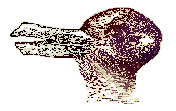
Figure 5
A duck/rabbit image
Wittgenstein’s philosophical goal is not to produce theories or theses, but to change our way of looking at things, to change our way of seeing the world. (My reading moves into the center of Wittgenstein’s methodology his discussions of Jastrow’s duck/rabbit image.(Fig. 5))(9) My strategy in this paper is to make Duchamp’s and Ernst’s works of art emblems for two distinct ways of changing the way we see the world. For ease of reference, I will label Duchamp’s way the “surface” way, and Ernst’s the “depth” way. I see Duchamp and Wittgenstein in alliance here. If Ernst needs a philosophical depth companion, let’s give him Vulgar Freudianism. Duchamp’s and Wittgenstein’s way, the “nothing is hidden”(10) way, appeals to what is before our eyes. Ernst’s work, by contrast, appeals to depth, to a structure hidden beneath the surface.(Fig. 6)
click to enlarge
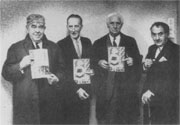
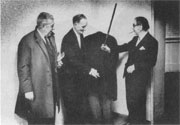
Figure 6
Pictures on the left showing (from left to right) René Magritte, Marcel Duchamp, Max Ernst, and Man Ray, attending Bill Copleys exhibition at the Stedelijk Museum, line up holding a copy of the exhibition catalogue, in which announces “Tremendous Deliriums”; on the right, Ernst turns around with his head down, while Duchamp poses his fingers at, and Man Ray raises his cane as if to strike him. Photograph by Ed van der Elsken, 1966.
In order to clarify what I mean by the “depth” way, let us now look more deeply at The Hat Makes the Man. If you had a feeling of unfamiliarity, or eerie strangeness, when looking at it before, part of the reason might be the German words in the corner: none of them are capitalized. There is a remark on this phenomenon in Wittgenstein’s Remarks on the Philosophy of Psychology, vol. 1:
RPP I 1087. German nouns printed in lower-case letters in certain modern poets. A German noun all in lower-case letters looks alien; to recognize it, one has to read it attentively. It is supposed to strike us as new, as if we had seen it now for the first time.–(11)
If that is not enough, in the Ernst work the words are a portmanteau of the made up, the nonsensical and the rare: a bit like a Teutonic Lewis Carroll poem: Jabberwocky, jawohl.(12) A transcription of Ernst’s Germanic words are(13):
bedecktsamiger stapel-mensch nacktsamiger wasserformer (“edelformer”) kleidsame nervatur auch umpressnerven!
Half these words are not really German. Nervatur is a specialized scientific term for a pattern of nerves or veins, and bedecktsamiger and nacktsamiger are rare scientific terms. We (14) might translate the phrase:
angiospermous stack- man gymnospermous waterformer (“nobleformer”) flattering nervation also !transpressnerves!
The American Heritage College Dictionary, Third edition, Houghton Mifflin, 1993, informs us of the meaning of the rare terms:
angiosperm n., A plant whose ovules are enclosed in an ovary; a flowering plant. gymnosperm n., A plant, such as a cycad or conifer, whose seeds are not enclosed within an ovary.
And, for those whose college biology is receding:
ovule n., A minute structure in seed plants, containing the embryo sac and surrounded by the nucellus, that develops into a seed after fertilization.
Both German scientific nouns are direct translations of the Greek scientific terms; if English worked the same way, then “angiosperm” and “gymnosperm” would be “coveredseed” and nakedseed”.
Combining the words and the image, we can see that the work is partly a meditation on what is hidden and what is unclothed, and that Ernst has uncovered for us a coveredseed. This is a picture of a nerve system, and Ernst is portraying an underlying skeletal or nerve structure.
Let us now add the (linguistically) unproblematic French below the German:
(c’est le chapeau qui fait l’homme)
(le style c’est le tailleur)
And the translation:
(the hat makes the man)
(style [the manner, the tone of the man] is the tailor) (15)
The unproblematic French gives us the wonderfully complicated further point that it’s style all the way down! If we add that “chapeau” is also an old slang word for condom,(16) then the covering of seed and the image itself become spectacularly complex. Ernst was both a student of philosophy and of psychiatry; if ever a picture called for a Freudian interpretation, even a vulgar one, it is this.
click to enlarge
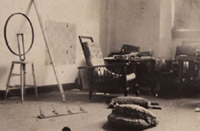
Figure 7
Marcel Duchamp, Photograph of
Duchamp’s Studio, 1916-1917
Ernst has taken the familiar sight of a man and a hat and, going beneath the surface, made it unfamiliar. In contrast, Duchamp has taken a supposedly familiar, ordinary object, and defamiliarized it by a change in location and status. (The change is what Russell and Bradley would have called a change in external relations.) Duchamp’s Trébuchet is areadymade: a genre that Duchamp invented and named. The idea, or, perhaps, more accurately, the propaganda, is to take a found object – often a mass produced manufactured object; a familiar, repeated object – and turn it into a work of art, perhaps by signing it, perhaps by placing it in a museum. The legend is that in 1917, while an expatriate from the European war, Marcel Duchamp purchased a coat rack, nailed it to the floor of his New York City apartment,(Fig. 7) and then named this new work of art: “Trébuchet“. The Ernst and Duchamp works have this in common: both take the familiar and then make it unfamiliar: it is the way they make it unfamiliar that is different.
Putting the art works aside for a moment, as a way of further illustrating the differences between the ways of depth and surface, let us go back to the question of what makes us go wrong, what leads us to mistake? Familiarly, one side answers “deception” – whether psychological, social, or political: there is something hidden that needs to be uncovered; we need to leave our usual, surface haunts for the unfamiliar, where the truth lies. (Sometimes the theory is that identifying the deception accomplishes the uncovering of the truth.) As in the Ernst work all is not what it appears: in order to understand the men before our eyes, we have to go down to their underlying structure. Wittgenstein, on the contrary, says in theInvestigations “…For what is hidden, for example, is of no interest to us” [PI: 126](17) and:
361. In order to climb into the depths one does not need to travel very far; no, for that you do not need to abandon your immediate and accustomed environment. [RPP I]
To go down into the depths you don’t need to travel far; you can do it in your own backgarden. [CV p. 57](18)
Or, from a draft of the forward to Philosophical Remarks:
I might say: if the place I want to reach could only be climbed up to by a ladder, I would give up trying to get there. For the place to which I really have to go is one that I must actually be at already.
Anything that can be reached with a ladder does not interest me. [CV: p. 10]
Going from one kind of scripture to another, I am reminded of G-d’s directions to Moses in Deuteronomy 30 11-14:
“Surely, this Instruction which I enjoin upon you this day is not too baffling for you, nor is it beyond reach. It is not in the heavens, that you should say, ‘Who among us can go up to the heavens and get it for us and impart it to us, that we may observe it?’ Neither is it beyond the sea, that you should say: ‘Who among us can cross to the other side of the sea and get it for us and impart it to us, that we may observe it?’ No, the thing is very close to you, in your mouth, and in your heart, to observe it.”
It is perhaps now time to summon the old self-referential joke: there are two kinds of people in the world – those that divide kinds of people into two and those who do not. We should not confuse the surface/depth dichotomy with another one: those who see the world as problematic and those who do not. It is hard to imagine a philosopher (as opposed to, say, a politician) in the unproblematic camp.
Let us, then, quickly eliminate the vulgar interpretation that attention to the surface means simple common sense and that the world is uncomplicated and unproblematic. [Ross Perot’s voice and accent are in the background, saying: “It’s really all very simple.”] Both the surface skaters and the depth divers see the world as bubbingly complicated. Both believe we are inclined (at least at times), to see the world wrong. Both believe that the world as it strikes us requires a great deal of analysis – but they locate the complications in different places, give different accounts of where and how we go wrong, and engage in different kinds of analyses.(19)
Where are we now? In the context of our surface/depth dichotomy we have an overlapping and crisscrossing [PI: 67] of various themes: how to make a mistake, what is hidden, what lies open to plain view, and, lurking [hidden!?] in the background, the continual debates on Wittgenstein’s alleged quietism: the accusation that philosophy requires not investigation but renunciation.(20) The central texts of Wittgenstein’s alleged quietism are, of course,Investigations 124-6, where Wittgenstein writes that “Philosophy may in no way interfere with the actual use of language […] [i]t leaves everything as it is […] Philosophy simply puts everything before us, and neither explains nor deduces anything. […]”)(21)
Let us begin to unravel these threads by returning to the coat and hat rack images experiment and focusing on the question of familiarity. Do you have some particular feeling of familiarity? (To those of you familiar with Wittgenstein, this will, of course, be a familiar experiment with some familiar answers; what I hope to accomplish is to put it into a new – or, at least, less examined — context.)
Consider the following group of remarks from the Philosophical Investigations.(22) (Non-incidentally, these remarks are prefaced by an assertion that many – but most especially depth investigators — find one of the most annoying in Wittgenstein’s corpus: PI: 599: … “Philosophy only states what everyone admits”. Often those who find a quietism of renunciation in Wittgenstein also see him as bullying instead of arguing.)
602. Asked “Did you recognize your desk when you entered your room this morning?”–I should no doubt say “Certainly!” And yet it would be misleading to say that an act of recognition had taken place. Of course the desk was not strange to me; I was not surprised to see it, as I should have been if another one had been standing there, or some unfamiliar kind of object.
603. No one will say that every time I enter my room, my long-familiar surroundings, there is enacted a recognition of all that I see and have seen hundreds of times before.
604. It is easy to have a false picture of the processes called “recognizing”; as if recognizing always consisted in comparing two impressions with one another. It is as if I carried a picture of an object with me and used it to perform an identification of an object as the one represented by the picture. Our memory seems to us to be the agent of such a comparison, by preserving a picture of what has been seen before, or by allowing us to look into the past (as if down a spy-glass).
605. And it is not so much as if I were comparing the object with a picture set beside it, but as if the object coincided with the picture. So I see only one thing, not two.
We began this paper with a (chess) mistake. What mistake is Wittgenstein warning us against here? In this context Wittgenstein is being fairly explicit: the mistake is to assume that because S recognizes y, an act of recognition must have taken place. This seemingly simple mistake opens the door to a string of others. Since even superficial investigation (introspection will do) reveals that there is not always a conscious act of recognition (as I hope your own familiarity experiment and experiences have shown), that (alleged) act is driven underground – the depth arguer has to claim there is a hidden mechanism underlying our overt behavior. Wittgenstein’s telling of the depth story is an oft told tale: failure to appreciate differences leads one to assume essences (or is it the other way around?); since there must be an essence – a seed – and since there is obviously no gymnosperm[nakedseed], there must be an angiosperm [a coveredseed].(23) And then, as Hume says in the An Enquiry Concerning Human Understanding, “We are got into fairy land, long ere we have reached the last steps of our theory.”(24)
This is a particular breed of a more general kind of Wittgensteinean warning of How Not to Do Philosophy. PI: 35 discusses the “’characteristic experiences’ of pointing”, connects it directly to our problem via the Wittgensteinean device of a parenthetical footnote [“(Recognizing, wishing, remembering, etc. .)”], then draws a more general moral:
PI: 36. And we do here what we do in a host of similar cases: because we cannot specify any one bodily action which we call pointing to the shape (as opposed, for example, to the colour), we say that a spiritual [mental, intellectual] activity corresponds to these words.
Where our language suggests a body and there is none: there, we should like to say, is a spirit.(Fig. 8)
click to enlarge

Figure 8
Marcel Duchamp, Tu m’, 1918
Wittgenstein then turns instead to a host of ordinary, contextually particular, surface considerations:
37. What is the relation between name and thing named?–Well, what is it? Look at language-game (2) or at another one: there you can see the sort of thing this relation consists in. This relation may also consist, among many other things, in the fact that hearing the name calls before our mind the picture of what is named; and it also consists, among other things, in the name’s being written on the thing named or being pronounced when that thing is pointed at.
Going back to recognition and familiarity, we can connect PI: 37 to PG: 166 [the original home of PI: 602ff.]:
PG: 166 So the multiplicity of familiarity, as I understand it, is that of feeling at home in what I see. It might consist in such facts as these: my glance doesn’t move restlessly (inquiringly) around the object. I don’t keep changing the way I look at it, but immediately fix on one and hold it steady.
Remarks on the Philosophy of Psychology, vol. 1 also makes the connection explicit:
RPP I 166: It may be asked: Does something always come into my head when I understand a word?! (The following question is similar: “When I look at a familiar object, does an act of recognition always take place?”)
The philosophical mistake, the philosopher’s mistake, is to search for something extra in the explanation of our ordinary goings on.(25) (And even worse, but almost inevitable, is to findthat something extra: this structure or that. Here, in Wittgenstein’s lights, the philosopher is like the cheap stage magician, placing the rabbit in the hat to pull it out later.)
There is a familiar (to the point of being well trodden) Wittgenstein path here: this illusory extra will then serve as the criterion (and, if met, the guarantee) of an activity that, to the contrary, only makes sense, can only be seen as the activity it is, or indeed, an activity at all, when looked on as part of a practice. This is (partly) the concern of PI: 149 and the famous rule following sections of the Investigations:
PI: 149. If one says that knowing the ABC is a state of the mind, one is thinking of a state of a mental apparatus (perhaps of the brain) by means of which we explain the manifestations of that knowledge. Such a state is called a disposition. But there are objections to speaking of a state of the mind here, inasmuch as there ought to be two different criteria for such a state: a knowledge of the construction of the apparatus, quite apart from what it does. (Nothing would be more confusing here than to use the words “conscious” and “unconscious” for the contrast between states of consciousness and dispositions. For this pair of terms covers up a grammatical difference.)
The moral so far is: if depth is taken as the a priori requirement of a hidden, underlying structure, then the pursuit of that alleged depth and structure is a task of illusion, superstition: (often under the name of science) a pseudo-scientific alchemy.
But there is another (not at all completely unrelated) sense to depth. Wittgenstein writes inZettel of the real (it has happened) danger of the real (non-illusory) loss of real (not based on a mistake) depth:
Z 456. Some philosophers (or whatever you like to call them) suffer from what may be called “loss of problems”. Then everything seems quite simple to them, no deep problems seem to exist any more, the world becomes broad and flat and loses all depth, and what they write becomes immeasurably shallow and trivial.(26)
>This is the real question we have been asking all along: How does the world become deep? Or, somewhat more precisely in the light of our previous discussion: How does the surface take on a depth?
Wittgenstein sometimes profitably investigated these questions by examining the more particular question: What happens when one comes to understand something?(27)
(Perhaps the warning is unnecessary, but attention to art helps remind us that understanding is not a binary on/off operation: it is not as if the internal mechanism finally works and now I understand Duchamp’s Trébuchet; it is not as if I have a feeling and then suddenly I understand Ernst’s The Hat Makes the Man. The illusion that a non-limited, non-contextual sense can be made of complete understanding goes along with the illusion that a non-limited, non-contextual sense can be made of a hidden guarantee of our practices.)
How, in coming to understand something, does it acquire a legitimate kind of depth? We can now answer this by putting all the elements together. The answer is: by putting all the elements together. (In a local way of course, and for a time.)
Wittgenstein continually argues there is nothing [no thing] extra, added on, in our coming to understand. Coming to understand, as the relation between name and thing named [PI: 37], as the multiplicity of familiarity [PG: 166], is a plurality of commonplaces: it is the manner that makes the man. In philosophy we come to understand by seeing connections:
[PI: 122] A main source of our failure to understand is that we do not perspicuously overview [ubersehen] the use of our words. –Our grammar is lacking in this sort of perspicuity [Ubersichtlichkeit]. A perspicuous presentation [ubersichtliche Darstellung] produces just that understanding which consists in ‘seeing connections’. Hence the importance of finding and inventingintermediate cases.
The concept of a perspicuous presentation is of fundamental significance for us. It earmarks the form of account we give, the way we look at things. (Is this a ‘Weltanschauung’?)(28)
What changes when we come to understand are not the facts, but the attitude. The change is a change of perspective; a rearrangement of what has been in front of us all along.
Coming to understand is the both the substance and the style [never mere style] of Wittgenstein’s later philosophy. It is coming to understand: process, not conclusion. Through his use of examples, his meandering methodology, his intermediate cases, his juxtaposition of situations, Wittgenstein is showing us how the surface acquires depth. The manner makes the books.
It is in this fashion, as well, that we come to understand Duchamp’s Trébuchet. Let’s look for a moment at the multiplicity and juxtaposition of meanings here:
click to enlarge
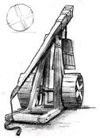
Figure 9
The Medieval war machine

Figure 10
The cucking stool

Figure 11
The ducking stool
Duchamp was a lover of many things, including lists, dictionaries, and self-reference. High on his list of loves was dictionaries.(29) If he had looked up “trébuchet” in an ordinary French dictionary he would have found the following three senses:
1. A medieval war machine [which the coat rack visually resembles];(Fig. 9)
2. A bird trap; and
3. A very accurate scale used in laboratories.
If he also looked up “trébuchet” in a comprehensive English dictionary, he would have seen the additional sense:
4. A cucking- or ducking-stool.(30)(Figs. 10, 11)
In addition, there is:
5. A pun with the homonymic French verb “trébucher“, which means “to stumble or trip”, which is precisely what one would do with a coat rack nailed to the floor.
And, of course, there is
6. A technical chess meaning, a mutual or reciprocal zugzwang, where whoever moves loses.
The image and the multiplicity of meanings work together to change our way of looking at things: Duchamp has inclined us to see the unfamiliar in a formerly familiar and common place hat rack.
click to enlarge

Figure 12
Marcel Duchamp, Door: 11, rue Larrey, 1927
Two of Wittgenstein’s students wrote that:
Wittgenstein once described the situation in philosophy thus: ‘It is as if a man is standing in a room facing a wall on which are painted a number of dummy doors. Wanting to get out, he fumblingly tries to open them, vainly trying them all, one after the other, over and over again. But, of course, it is quite useless. And all the time, although he doesn’t realize it, there is a real door in the wall behind his back, and all he has to do is to turn around and open it. To help him get out of the room all we have to do is to get him to look in a different direction. But it’s hard to do this, since, wanting to get out, he resists our attempts to turn him away from where he thinks the exit must be.’(31)(Fig. 12)
A serious warning is necessary here. The description I just read makes it seem a little too easy to dissolve philosophical problems: it has its truth about Wittgenstein’s methodology, but it has to be counterbalanced by attention to the theme that philosophical problems cannot be dismissed, cannot be renounced, but have to be worked through. However, since I have examined this theme of working through elsewhere, and since I’ll shortly close with a similar warning, I’ll bracket it off in this essay.
We here have a constant in Wittgenstein’s career: Early, Middle, and Late Wittgenstein focused on the agent’s attitude. It is through changes in the agent’s attitude that the surface acquires depth. Wittgenstein, of course, located the ethical in that attitude. As early as 1916, Wittgenstein recorded in his Notebooks:
In order to live happily I must be in agreement with the world. And that is what “being happy” means. [NB: p. 75]
The will is an attitude of the subject to the world. [NB: p. 87]
click to enlarge

Figure 13
Original version in Wittgenstein’s
Tractatus
This kind of view survives in the Tractatus’ discussion of perspective:
5.5423 To perceive a complex means to perceive that its constituents are related to one another in such and such a way.
This no doubt also explains why there are two possible ways of seeing the figure(32) as a cube; and all similar phenomena. For we really see two different facts.
(If I look in the first place at the corners marked a and only glance at the b’s, then the a’s appear to be in front, and vice versa). (Fig. 13)
And in his discussion of ethics:
6.43 If the good or bad exercise of the will does alter the world, it can alter only the limits of the world, not the facts–not what can be expressed by means of language.
In short the effect must be that it becomes an altogether different world. It must, so to speak, wax and wane as a whole.
The world of the happy man is a different one from that of the unhappy man.
Throughout his career Wittgenstein’s attitude toward attitude remains the same. A real change, however, is that in his later philosophy, Wittgenstein becomes much more concerned with diagnosing the reasons some are not satisfied with that answer.
The temptation, Wittgenstein comes to claim, is to confuse the illusory notion of depth with the real notion of seeing connections, of really seeing what is before our eyes. In order to see the world in depth one needs to really pay attention to the surface:
RFM: p. 102 (Here we stumble on a remarkable and characteristic phenomenon in philosophical investigation: The difficulty–I might say–isn’t one of finding the solution; it is one of recognizing something as the solution. We have already said everything. Not something that follows from this; no, just this is the solution!
This, I believe, hangs together with our wrongly expecting an explanation; whereas a description is the solution of the difficulty, if we give it the right place in our consideration. If we dwell upon it and do not try to get beyond it.)
click to enlarge
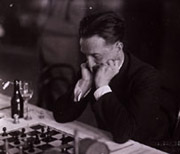
Figure 14
Photograph of Duchamp playing chess,
circa 1930s
What kind of mistake is 1. … Ke4, rushing in to take the pawn? What kind of mistake is failing to see the connections before us? They are not identical, but they are cousins. The chess player rushes in to take the pawn; eager to win material he is too aggressive, moving too close too soon, instead of taking his time.(33) By failing to notice what is there, he ends up on the wrong side of a trébuchet. The chess player does not need a secret revealed, a card turned over; what he needs is to control himself.(Fig. 14)
So, partly too, the philosopher. Wittgenstein’s chapter “Philosophy” in the so-called “Big Typescript” of 1932 includes the fragment:
PO: 162-63: Work on philosophy is – as work in architecture frequently is – actually more of a //a kind of// work on oneself. On one’s own conception. On the way one sees things. (And what one demands of them.)
And even more directly, the chapter begins with the following heading in capital letters:
DIFFICULTY OF PHILOSOPHY NOT THE INTELLECTUAL DIFFICULTY OF THE SCIENCES, BUT THE DIFFICULTY OF A CHANGE OF ATTITUDE. RESISTANCES OF THE WILL MUST BE OVERCOME. (PO: 162)
And now, as is both rhetorically and philosophically required, I will close with a warning. We should not think of the difficulty or resistance here as a psychological matter, as an individual’s quirk. Wittgenstein’s sights were broader, surveying (and diagnosing) his whole culture. As he wrote in the Foreword to Philosophical Remarks:
This book is written for such men as are in sympathy with its spirit. This spirit is different from the one which informs the vast stream of European and American civilization in which all of us stand. That spirit expresses itself in an onwards movement, in building ever larger and more complicated structures; the other in striving after clarity and perspicuity in no matter what structure.(34)
In these matters the individual needs neither psychoanalysis nor shock therapy; it isphilosophy that is required: a philosophical striving after clarity and perspicuity, a philosophical straining (and training) to constantly conquer temptation anew and to see the sense visible amidst the nonsense and the nonsense clothed as sense.(35)
Notes
 1.The Collected Works of Ludwig Wittgenstein, Past Masters, InteLex Corporation. In referring to Wittgenstein’s works I will use the Wittgenstein industry standard abbreviations:
1.The Collected Works of Ludwig Wittgenstein, Past Masters, InteLex Corporation. In referring to Wittgenstein’s works I will use the Wittgenstein industry standard abbreviations:
BB: Blue and Brown Books
PI: Philosophical Investigations
RPP I: Remarks on the Philosophy of Psychology, Vol. 1
LWPP I: Last Writings on the Philosophy of Psychology, Vol. 1
PG: Philosophical Grammar
CV: Culture and Value
RFM: Remarks on the Foundations of Mathematics
PO: Philosophical Occasions
PR: Philosophical Remarks
Z: Zettel
Unless otherwise indicated, references will be to the section number.
 2. Vitaly Halberstadt and Marcel Duchamp, L’Opposition et les Cases Conjugées sont Reconciliées[Opposition and Sister Squares are Reconciled] (Paris/Bruxelles: L’Echiquier, 1932) text in English, French and German.
2. Vitaly Halberstadt and Marcel Duchamp, L’Opposition et les Cases Conjugées sont Reconciliées[Opposition and Sister Squares are Reconciled] (Paris/Bruxelles: L’Echiquier, 1932) text in English, French and German.
 3. Halberstadt and Duchamp, p. 9, Diagram 15. In a position almost identical to Duchamp’s Diagram 15 (our diagram 1), Aron Nimzovich, My System [original German, Mein System, 1925; first English translation 1929] p. 69, gives essentially the same analysis (without, however, using the term “trébuchet”):
3. Halberstadt and Duchamp, p. 9, Diagram 15. In a position almost identical to Duchamp’s Diagram 15 (our diagram 1), Aron Nimzovich, My System [original German, Mein System, 1925; first English translation 1929] p. 69, gives essentially the same analysis (without, however, using the term “trébuchet”):
WHITE: Kd6, Pc5
BLACK: Ka5, Pc6
the continuation is: 1. K-Q7!, K-Kt4; 2. K-Q6; but not 1. K-Q6?, because of …. K-Kt4, and White has no good move left, and is in fact himself in Zugzwang, in a strait jacket, shall we say?
 4. Eugene A. Znosko-Borovsky, How Not to Play Chess, ed. Fred Reinfeld (Dover, 1949) [first English version 1931], p. 31
4. Eugene A. Znosko-Borovsky, How Not to Play Chess, ed. Fred Reinfeld (Dover, 1949) [first English version 1931], p. 31
 5. Larry Evans, The 10 Most Common Chess Mistakes … and how to avoid them! (Cardoza, 1998 and 2000)123
5. Larry Evans, The 10 Most Common Chess Mistakes … and how to avoid them! (Cardoza, 1998 and 2000)123
 7. Max Ernst, The Hat Makes the Man. 1920. Cut-and-pasted paper, pencil, ink and watercolor on paper, 14 x 18″ (35.6 x 45.7 cm) The Museum of Modern Art, NY.
7. Max Ernst, The Hat Makes the Man. 1920. Cut-and-pasted paper, pencil, ink and watercolor on paper, 14 x 18″ (35.6 x 45.7 cm) The Museum of Modern Art, NY.
 8. For a different discussion of the same passage and point, see my “How Old Are These Bones? Putnam, Wittgenstein and Verification”, Proceedings of the Aristotelian Society, Supplementary Volume LXXIII (1999)
8. For a different discussion of the same passage and point, see my “How Old Are These Bones? Putnam, Wittgenstein and Verification”, Proceedings of the Aristotelian Society, Supplementary Volume LXXIII (1999)
 10.See PI: 435: “…How do sentences do it?–Don’t you know? For nothing is hidden.” See also PG: p. 104: “How does a sentence do it? Nothing is hidden.”
10.See PI: 435: “…How do sentences do it?–Don’t you know? For nothing is hidden.” See also PG: p. 104: “How does a sentence do it? Nothing is hidden.”
 11. The remark continues:
11. The remark continues:
But what interests me here? This–that the impression can’t at first be described more exactly than by means of words like ‘queer’, ‘unaccustomed’. Only later follow, so to speak, analyses of the impression. (The reaction of recoil from the strangely written word.)
 13. My discussion of Ernst’s German is overwhelmingly indebted to Ned Humphrey, a freelance German translator (and my freshman year college roommate). The translations are completely his, and he gave me the Teutonic Carroll phrase as well as other bits of wisdom. I could not be more grateful for his generous help.
13. My discussion of Ernst’s German is overwhelmingly indebted to Ned Humphrey, a freelance German translator (and my freshman year college roommate). The translations are completely his, and he gave me the Teutonic Carroll phrase as well as other bits of wisdom. I could not be more grateful for his generous help.
 17. See also PO: 177. The surface explorers and the depth spelunkers call for and practice two very different kinds of investigations (and art). (The surrealisms of Duchamp, on the one hand, and Ernst, Magritte, and Dali, on the other, are really quite different.)
17. See also PO: 177. The surface explorers and the depth spelunkers call for and practice two very different kinds of investigations (and art). (The surrealisms of Duchamp, on the one hand, and Ernst, Magritte, and Dali, on the other, are really quite different.)
 18. From MS 131 182: 2.9.1946. The editors footnote as a variant: “indeed for this you need not even leave your most immediate & familiar surroundings I need not for this your most immediate…”.
18. From MS 131 182: 2.9.1946. The editors footnote as a variant: “indeed for this you need not even leave your most immediate & familiar surroundings I need not for this your most immediate…”.
 19. We might call the depth analysis “vertical” and the surface analysis “horizontal”. However, I’ll leave these metaphors to this endnote. An implicit burden of the rest of the paper is to see if sense can be made of any of the metaphors.
19. We might call the depth analysis “vertical” and the surface analysis “horizontal”. However, I’ll leave these metaphors to this endnote. An implicit burden of the rest of the paper is to see if sense can be made of any of the metaphors.
 20. In formulating the accusation of quietism this way, I am influenced by James Conant, “On Wittgenstein’s Philosophy of Mathematics,” section V (pp. 209-213).
20. In formulating the accusation of quietism this way, I am influenced by James Conant, “On Wittgenstein’s Philosophy of Mathematics,” section V (pp. 209-213).
 21. See John McDowell’s excellent discussions in his “Meaning and Intentionality in Wittgenstein’s Later Philosophy”, in P. French, et. al., The Wittgenstein Legacy, Midwest Studies in Philosophy, vol. xvii (University of Notre Dame Press, 1992); and Mind and World (Harvard, 1994) 92-3, and Afterword III (pp. 175-180). I previously discussed quietism in my “One Wittgenstein?” in E. Reck, ed., From Frege to Wittgenstein: Perspectives on Early Analytic Philosophy (Oxford University Press, 2001), from which I have cannibalized part of this note.
21. See John McDowell’s excellent discussions in his “Meaning and Intentionality in Wittgenstein’s Later Philosophy”, in P. French, et. al., The Wittgenstein Legacy, Midwest Studies in Philosophy, vol. xvii (University of Notre Dame Press, 1992); and Mind and World (Harvard, 1994) 92-3, and Afterword III (pp. 175-180). I previously discussed quietism in my “One Wittgenstein?” in E. Reck, ed., From Frege to Wittgenstein: Perspectives on Early Analytic Philosophy (Oxford University Press, 2001), from which I have cannibalized part of this note.
 23. PG: p. 74 has all the familiar elements: (at least) understanding, essence, family resemblances:
23. PG: p. 74 has all the familiar elements: (at least) understanding, essence, family resemblances:
35 The problem that concerns us could be summed up roughly thus: “Must one see an image of the colour blue in one’s mind whenever one reads the word ‘blue’ with understanding?” People have often asked this question and have commonly answered no; they have concluded from this answer that the characteristic process of understanding is just a different process which we’ve not yet grasped.–Suppose then by “understanding” we mean what makes the difference between reading with understanding and reading without understanding; what does happen when we understand? Well, “Understanding” is not the name of a single process accompanying reading or hearing, but of more or less interrelated processes against a background, or in a context, of facts of a particular kind, viz. the actual use of a learnt language or languages.–We say that understanding is a “psychological process”, and this label is misleading, in this as in countless other cases. It compares understanding to a particular process like translation from one language into another, and it suggests the same conception of thinking, knowing, wishing, intending, etc. That is to say, in all these cases we see that what we would perhaps naively suggest as the hallmark of such a process is not present in every case or even in the majority of cases. And our next step is to conclude that the essence of the process is something difficult to grasp that still awaits discovery. For we say: since I use the word “understand” in all these cases, there must be some one thing which happens in every case and which is the essence of understanding (expecting, wishing etc.). Otherwise, why should I call them by all the same name?
See also PI: 164:
164. In case (162) the meaning of the word “to derive” stood out clearly. But we told ourselves that this was only a quite special case of deriving; deriving in a quite special garb, which had to be stripped from it if we wanted to see the essence of deriving. So we stripped those particular coverings off; but then deriving itself disappeared.–In order to find the real artichoke, we divested it of its leaves. For certainly (162) was a special case of deriving; what is essential to deriving, however, was not hidden beneath the surface of this case, but his ‘surface’ was one case out of the family of cases of deriving.
 24. David Hume, An Enquiry Concerning Human Understanding, Section VII, Part I, next to last paragraph.
24. David Hume, An Enquiry Concerning Human Understanding, Section VII, Part I, next to last paragraph.
PI: 436 & PG: p. 169: Here it is easy to get into that dead-end in philosophy, where one believes that the difficulty of the task consists in our having to describe phenomena that are hard to get hold of, the present experience that slips quickly by, or something of the kind. Where we find ordinary language too crude, and it looks as if we were having to do, not with the phenomena of every-day, but with ones that “easily elude us, and, in their coming to be and passing away, produce those others as an average effect”.
The Investigations adds Augustine’s Latin: “(Augustine: Manifestissima et usitatissima sunt, et eadem rusus nimis latent, et nova est inventio eorum.)” In Book XI of the Confessions Augustine, confronting himself with making sense of time, sees paradox after paradox, and then reminds himself of our ordinary time-talk, writing: “They are perfectly obvious and ordinary, and yet the same things are too well hidden, and their discovery comes as something new.”
Philosophical Grammar, instead, adds the same thought as Augustine, but with a decidedly different spin:
PG 169. And here one must remember that all the phenomena that now strike us as so remarkable are the very familiar phenomena that don’t surprise us in the least when they happen. They don’t strike us as remarkable until we put them in a strange light by philosophizing.
PG: pp. 72-3: A truthful answer to the question “Did you understand the sentence (that you have just read)” is sometimes “yes” and sometimes “no”. “So something different must take place when I understand it and when I don’t understand it.”
Right. So when I understand a sentence something happens like being able to follow a melody as a melody, unlike the case when it’s so long or so developed that I have to say “I can’t follow this bit”. And the same thing might happen with a picture, and here I mean an ornament. First of all I see only a maze of lines; then they group themselves for me into well-known and accustomed forms and I see a plan, a familiar system. If the ornamentation contains representations of well-known objects the recognition of these will indicate a further stage of understanding. (Think in this connection of the solution of a puzzle picture.) I then say “Yes, now I see the picture rightly”.
And:
[BB: p. 168] Now we have used a misleading expression when we said that besides the experiences of seeing and speaking in reading there was another experience, etc. This is saying that to certain experiences another experience is added.–Now take the experience of seeing a sad face, say in a drawing,–we can say that to see the drawing as a sad face is not ‘just’ to see it as some complex of strokes (think of a puzzle picture). But the word ‘just’ here seems to intimate that in seeing the drawing as a face some experience is added to the experience of seeing it as mere strokes; as though I had to say that seeing the drawing as a face consisted of two experiences, elements.
 28. Following Juliet Floyd’s modified translation, who, in turn, is following Stanley Cavell. I discussed Floyd’s translation and analysis in my “How Old Are These Bones? Putnam, Wittgenstein and Verification”.
28. Following Juliet Floyd’s modified translation, who, in turn, is following Stanley Cavell. I discussed Floyd’s translation and analysis in my “How Old Are These Bones? Putnam, Wittgenstein and Verification”.
 29. An entry in The Green Box begins: “Take a Larousse dictionary and copy all the so-called ‘abstract,, words. i.e. those which have no concrete reference.”
29. An entry in The Green Box begins: “Take a Larousse dictionary and copy all the so-called ‘abstract,, words. i.e. those which have no concrete reference.”
 30. Quoting from Blackstone’s Commentaries:
30. Quoting from Blackstone’s Commentaries:
A common scold may be indicted, and if convicted shall be sentenced to be placed in a certain engine of correction called the trebucket, castigatory, or ducking-stool.
 31. D. A. T. Gasking and A. C. Jackson, “Wittgenstein as a Teacher”, in Ludwig Wittgenstein: The Man and His Philosophy, ed. K. T. Fann (Dell, 1967) 42
31. D. A. T. Gasking and A. C. Jackson, “Wittgenstein as a Teacher”, in Ludwig Wittgenstein: The Man and His Philosophy, ed. K. T. Fann (Dell, 1967) 42
 33. Yuri Averbakh and I. Maizelis, Pawn Endings, trans. Mary Lasher, Chess Digest, Inc., 1974, p. 10, Diagram 18, W: Ka4, Pa6, Pg5; B: Kb8, Pb6, Pg6: “White’s pawn on a6 and Black’s pawn on b6 […] are of the ‘look but do not touch’ variety; whoever attacks first loses.” (The position is what Znosko-Borovsky labels a “Quasi-trebuchet” in How to Play Chess Endings, p. 13). Averbakh and Maizelis go on to analyze the position in terms of co-ordinate squares, what Duchamp and Halberstadt called “sister squares”. The just published Glenn Flear, Improve Your Endgame Play, Everyman Chess, London, 2000, p. 44 gives a similar position and points out that the blunder of moving too close to the enemy pawn “would be embarrassing, a special double-zugzwang called a trébuchet, whoever is to move loses!”
33. Yuri Averbakh and I. Maizelis, Pawn Endings, trans. Mary Lasher, Chess Digest, Inc., 1974, p. 10, Diagram 18, W: Ka4, Pa6, Pg5; B: Kb8, Pb6, Pg6: “White’s pawn on a6 and Black’s pawn on b6 […] are of the ‘look but do not touch’ variety; whoever attacks first loses.” (The position is what Znosko-Borovsky labels a “Quasi-trebuchet” in How to Play Chess Endings, p. 13). Averbakh and Maizelis go on to analyze the position in terms of co-ordinate squares, what Duchamp and Halberstadt called “sister squares”. The just published Glenn Flear, Improve Your Endgame Play, Everyman Chess, London, 2000, p. 44 gives a similar position and points out that the blunder of moving too close to the enemy pawn “would be embarrassing, a special double-zugzwang called a trébuchet, whoever is to move loses!”
This book is written for such men as are in sympathy with its spirit. This spirit is different from the one which informs the vast stream of European and American civilization in which all of us stand. That spirit expresses itself in an onwards movement, in building ever larger and more complicated structures; the other in striving after clarity and perspicuity in no matter what structure. The first tries to grasp the world by way of its periphery–in its variety; the second at its centre–in its essence. And so the first adds one construction to another, moving on and up, as it were, from one stage to the next, while the other remains where it is and what it tries to grasp is always the same.
I would like to say ‘This book is written to the glory of God’, but nowadays that would be chicanery, that is, it would not be rightly understood. It means the book is written in good will, and in so far as it is not so written, but out of vanity, etc., the author would wish to see it condemned. He cannot free it of these impurities further than he himself is free of them.
November 1930 L. W.
 35. I am very grateful to Paul-Jon Benson for reading and commenting on an earlier draft. It would be impossible to exaggerate the help I received on this paper from Lydia Goehr. If this paper were only about mistakes, instead of containing them, then I would have listed her as co-author.
35. I am very grateful to Paul-Jon Benson for reading and commenting on an earlier draft. It would be impossible to exaggerate the help I received on this paper from Lydia Goehr. If this paper were only about mistakes, instead of containing them, then I would have listed her as co-author.
Figs. 2, 3, 7-8, 12, 14
©2003 Succession Marcel Duchamp, ARS, N.Y./ADAGP, Paris. All rights reserved.



